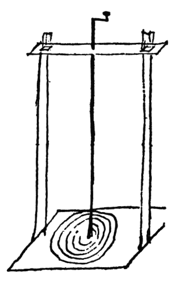From Benjamin Franklin to Hughes and Co.: Directions for Making a Musical Instrument, [1762]
To Hughes and Co.: Directions for Making a Musical Machine
AD: The Assay Office, Birmingham, England
In an advertisement for the armonica4 in the London Chronicle, June 17–19, 1762, addressed “To the Nobility, Gentry, &c., ”Charles James of Purpool Lane, near Gray’s Inn, called himself “The Maker [who] has been employed by the Gentleman who is the real Inventor, in the First ever made in England, and continues to be honoured with his Approbation.” In 1770 Franklin confirmed this claim to the extent of saying that James was “the only Workman here acquainted with such Matters.” He was, however, “a very negligent, dilatory Man,” and was now unable to supply one of Franklin’s friends because “at length he died suddenly.”5
It is evident, however, that at some period Franklin employed another glassblower. Writing to Polly Stevenson, March 25, 1763, he expressed his regret that James had been “dilatory” in making an armonica for another person and then commented: “I was unlucky in both the Workmen that I permitted to undertake making those Instruments. The first was fanciful, and never could work to the purpose, because he was ever conceiving some new Improvement that answer’d no End: the other [James], I doubt, is absolutely idle. I have recommended a Number to him from hence, but must stop my hand.”6 The “fanciful” workman was probably the “Mr. Barnes” of the firm of Hughes and Co. at the “Cockpit Glasshouse” to which the following directions were addressed. The document is undated, but is placed here at the end of 1762 because that was the year in which Franklin first described his musical invention, and it seems helpful to print the two papers in the same volume.7
[1762]
Messrs. Hughes and Co. at the Cockpit Glasshouse, opposite St. Paul’s.
A Set of musical Glasses, such as Mr. Franklin had, of the following Dimensions
| 6 of 2½ Inches diam. |  |
The Form of the Glasses |
| 6 of 3 | ||
| 6 of 3½ | ||
| 6 of 4 | ||
| 6 of 4½ | ||
| 6 of 5 | ||
| 6 of 5½ | The Sides to be as near as may be upright. The Necks of all an Inch deep; and in the smallest ¾ of an Inch Diameter; in the largest an Inch and half Diameter; the others in Proportion. | |
| 6 of 6 | ||
| 6 of 6½ | ||
| 6 of 7 | ||
| 6 of 7½ | ||
| 6 of 8. |
The upright of the Sides to be in the smallest ¾ of an Inch, adding a ¼ of an Inch to every larger Size, so that the upright of the largest will be 3½ Inches.
Mr. Barnes is desired to take Notice, that the Glasses are not to be made hollowing up, like those Mr. Franklin had last, but like those he had first with Bottoms nearly even.
 To fix them I us’d a Frame like the Figure in the Margin with an upright Iron Rod, on which was a Screw from End to End; The Rod turn’d on it’s Point.
To fix them I us’d a Frame like the Figure in the Margin with an upright Iron Rod, on which was a Screw from End to End; The Rod turn’d on it’s Point.
The Bottom Board had a Number of concentric Circles.
I had a Number of Brass female Screws, about an Inch long.
One of these was to be cemented in the Neck of each Glass.
On the Board I plac’d a round bit of Card a little bigger than the Neck of the Glass, then the female Screw upon that, then turn’d the Glass down with its Edge upon the Circles, then put the Screw Rod thro’ the Neck of the Glass and enter’d the female Screw, and drew it up with the Card till it came into the Neck of the Glass, the Card coming close to stop the Neck; then having center’d the Glass, I pour’d in the Cement. When cold, remov’d that Glass; and plac’d another. The Neck of the Glass should be a little warm’d, and the Cement not too hot.
When the Glasses were all furnish’d with Screws in their Necks; I put them on the Rod, a thin Piece of Cork between their Necks to screw them hard upon, and prevent Jarring and make each Screw water-tight.8
Endorsed: Mr. Franklins directions for making a Musical Machine Mr Franklins directions for Glasses Musical

4. See above, pp. 116–30.
5. To Michael Hillegas, March 17, 1770, The Historical Magazine, and Notes and Queries, III (1859), 213.
6. below, p. 235.
7. In the journal account book BF kept during his second mission to Great Britain is an entry dated Dec. 23, 1765, which may relate to the blowing of glasses for an armonica by the Cockpit Glasshouse: “Profit and Loss my draft in favour of Barnes & Co. Glasses per Bill £20 0s.”
8. In addition to the sketches on these pages, the MS contains one which is too indistinct to reproduce here or even to permit determination of its purpose.

![University of Virginia Press [link will open in a new window] University of Virginia Press](/lib/media/rotunda-white-on-blue.png)
